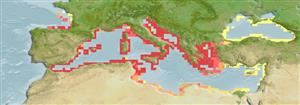分類 / Names
共通名の | 類義語 | Catalog of Fishes(部類, 種) | ITIS | CoL | WoRMS | Cloffa
>
Eupercaria/misc (Various families in series Eupercaria) >
Labridae (Wrasses)
Etymology: Symphodus: Greek, syn, symphysis = grown together + Greek, odous = teeth (Ref. 45335).
More on author: Linnaeus.
Issue
See nomenclatural details in Eschmeyer (CofF ver. Oct. 2012: Ref. 92135).
Environment: milieu / climate zone / depth range / distribution range
生態学
海 関連する礁; 深さの範囲 1 - 30 m. Subtropical; 47°N - 30°N, 6°W - 42°E
Eastern Atlantic: throughout the Mediterranean, Black Sea and Sea of Azov.
Length at first maturity / サイズ / 重さ / 年齢
Maturity: Lm 4.0 range ? - ? cm
Max length : 18.5 cm TL オス/雌雄の選別がない; (Ref. 122896); 最大公表体重: 81.69 g (Ref. 122896); 最大記録サイズ: 5 年 (Ref. 4742)
Adults are found near rocks and eel-grass beds. A nest of seaweed (Cystoseria) built and kept by male. Feed on bryozoans, hydroids, tubicolous, worms, shrimps, amphipods and mollusks. Males grow faster than females (Ref. 4742). Undergoes sex reversal (Ref. 4742). Oviparous, distinct pairing during breeding (Ref. 205).
Life cycle and mating behavior
Maturities | 繁殖 | Spawnings | Egg(s) | Fecundities | 幼生
Undergoes sex reversal (Ref. 4742). Oviparous, distinct pairing during breeding (Ref. 205). Males build dish shaped nests and guard the eggs (Ref. 205).
Quignard, J.-P. and A. Pras, 1986. Labridae. p. 919-942. In P.J.P. Whitehead, M.-L. Bauchot, J.-C. Hureau, J. Nielsen and E. Tortonese (eds.) Fishes of the north-eastern Atlantic and the Mediterranean. UNESCO, Paris. Vol. 2. (Ref. 4742)
Human uses
水産業: 商業; 水族館・水槽: 商業
用具
特記事項
XMLをダウンロードして下さい
インターネットの情報源
Estimates based on models
Preferred temperature (Ref.
123201): 16.5 - 21.1, mean 18.9 °C (based on 421 cells).
Phylogenetic diversity index (Ref.
82804): PD
50 = 0.5005 [Uniqueness, from 0.5 = low to 2.0 = high].
Bayesian length-weight: a=0.01202 (0.00993 - 0.01456), b=3.09 (3.05 - 3.13), in cm total length, based on LWR estimates for this species (Ref.
93245).
栄養段階 (Ref.
69278): 3.5 ±0.0 se; based on diet studies.
Generation time: 1.7 ( na - na) years. Estimated as median ln(3)/K based on 1
growth studies.
回復力 (Ref.
120179): 手段, 1.4年~4.4年の倍増期間の最小個体群 (K=0.64-0.95; tm=1-2; tmax=5).
Fishing Vulnerability (Ref.
59153): Low vulnerability (22 of 100).
Nutrients (Ref.
124155): Calcium = 71.6 [33.6, 157.3] mg/100g; Iron = 0.872 [0.452, 1.799] mg/100g; Protein = 19.2 [16.3, 21.4] %; Omega3 = 0.25 [0.13, 0.47] g/100g; Selenium = 11.8 [5.3, 25.3] μg/100g; VitaminA = 75.2 [20.7, 354.1] μg/100g; Zinc = 1.27 [0.76, 2.19] mg/100g (wet weight);
